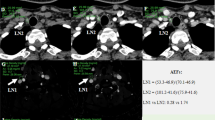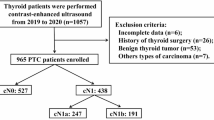Abstract
Objectives
To examine the value of CEUS as a non-invasive tool in detecting lateral neck metastasis (LNM) and the enhancement patterns of malignant lymph nodes (LN) for thyroid cancer patients.
Methods
Eighty-two consecutive patients, who underwent both preoperative non-enhanced US and CEUS examinations, were retrospectively reviewed. All patients underwent lateral neck dissection (LND). Enhancement patterns of 102 collected LNs matching to CEUS findings were analyzed.
Results
CEUS detected LNM in 53 of 65 patients, showing a higher sensitivity and accuracy than that of conventional US (p = 0.109 and p = 0.154, respectively). Thirteen patients’ surgical procedures were altered by CEUS findings, including nine true positive and four false positive cases. Five patients’ surgical procedures were altered by conventional US findings, including two true positive and three false positive cases. Heterogeneous enhancement, perfusion defects, microcalcification, and centripetal/hybrid enhancement were all specific criteria for malignant LNs in univariate analysis. In multivariate analysis, only heterogeneous enhancement and centripetal/hybrid enhancement were significantly related to LN metastasis (p = 0.000 and p = 0.037, respectively).
Conclusions
CEUS may be a potential tool to facilitate conventional US in detecting LNM. Heterogeneous enhancement and centripetal/hybrid enhancement are useful criteria to distinguish between malignant and benign LNs.
Key Points
• CEUS findings facilitated conventional US in detecting LNM.
• Heterogeneous, centripetal/hybrid enhancement, microcalcification and perfusion defects were specific criteria of malignant LNs.
• Heterogeneous and centripetal/hybrid enhancement were significantly related to LN metastasis in multivariate analysis.
Similar content being viewed by others
Abbreviations
- CEUS:
-
Contrast-enhanced ultrasound
- LNM:
-
Lateral neck metastasis
- LND:
-
Lateral neck dissection
- LN:
-
Lymph node
- TC:
-
Thyroid cancer
References
Schlumberger MJ (1998) Papillary and follicular thyroid carcinoma. N Engl J Med 338:297–306
McGregor GI, Luoma A, Jackson SM (1985) Lymph node metastases from well-differentiated thyroid cancer. A clinical review. Am J Surg 149:610–612
Shaha AR, Shah JP, Loree TR (1996) Patterns of nodal and distant metastasis based on histologic varieties in differentiated carcinoma of the thyroid. Am J Surg 172:692–694
Noguchi S, Noguchi A, Murakami N (1970) Papillary carcinoma of the thyroid. I. Developing pattern of metastasis. Cancer 26:1053–1060
Machens A, Hauptmann S, Dralle H (2009) Lymph node dissection in the lateral neck for completion in central node-positive papillary thyroid cancer. Surgery 145:176–181
White ML, Gauger PG, Doherty GM (2007) Central lymph node dissection in differentiated thyroid cancer. World J Surg 31:895–904
Torlontano M, Attard M, Crocetti U et al (2004) Follow-up of low risk patients with papillary thyroid cancer: role of neck ultrasonography in detecting lymph node metastases. J Clin Endocrinol Metab 89:3402–3407
Pacini F, Molinaro E, Castagna MG et al (2003) Recombinant human thyrotropin-stimulated serum thyroglobulin combined with neck ultrasonography has the highest sensitivity in monitoring differentiated thyroid carcinoma. J Clin Endocrinol Metab 88:3668–3673
Frasoldati A, Pesenti M, Gallo M, Caroggio A, Salvo D, Valcavi R (2003) Diagnosis of neck recurrences in patients with differentiated thyroid carcinoma. Cancer 97:90–96
Roh JL, Kim JM, Park CI (2008) Lateral cervical lymph node metastases from papillary thyroid carcinoma: pattern of nodal metastases and optimal strategy for neck dissection. Ann Surg Oncol 15:1177–1182
Nemec U, Nemec SF, Novotny C, Weber M, Czerny C, Krestan CR (2012) Quantitative evaluation of contrast-enhanced ultrasound after intravenous administration of a microbubble contrast agent for differentiation of benign and malignant thyroid nodules: assessment of diagnostic accuracy. Eur Radiol 22:1357–1365
Zhang B, Jiang YX, Liu JB et al (2010) Utility of contrast-enhanced ultrasound for evaluation of thyroid nodules. Thyroid 20:51–57
Agha A, Hornung M, Rennert J et al (2011) Contrast-enhanced ultrasonography for localization of pathologic glands in patients with primary hyperparathyroidism. Surgery 151:580–586
Agha A, Hornung M, Stroszczynski C, Schlitt HJ, Jung EM (2013) Highly efficient localization of pathological glands in primary hyperparathyroidism using contrast-enhanced ultrasonography (CEUS) in comparison with conventional ultrasonography. J Clin Endocrinol Metab 98:2019–2025
Yu M, Liu Q, Song HP et al (2010) Clinical application of contrast-enhanced ultrasonography in diagnosis of superficial lymphadenopathy. J Ultrasound Med 29:735–740
Leboulleux S, Girard E, Rose M et al (2007) Ultrasound criteria of malignancy for cervical lymph nodes in patients followed up for differentiated thyroid cancer. J Clin Endocrinol Metab 92:3590–3594
Antonelli A, Miccoli P, Ferdeghini M et al (1995) Role of neck ultrasonography in the follow-up of patients operated on for thyroid cancer. Thyroid 5:25–28
Rosario PW, de Faria S, Bicalho L et al (2005) Ultrasonographic differentiation between metastatic and benign lymph nodes in patients with papillary thyroid carcinoma. J Ultrasound Med 24:1385–1389
Grant CS, Hay ID, Gough IR, Bergstralh EJ, Goellner JR, McConahey WM (1988) Local recurrence in papillary thyroid carcinoma: is extent of surgical resection important? Surgery 104:954–962
Hay ID, Thompson GB, Grant CS et al (2002) Papillary thyroid carcinoma managed at the Mayo Clinic during six decades (1940–1999): temporal trends in initial therapy and long-term outcome in 2444 consecutively treated patients. World J Surg 26:879–885
Leboulleux S, Rubino C, Baudin E et al (2005) Prognostic factors for persistent or recurrent disease of papillary thyroid carcinoma with neck lymph node metastases and/or tumor extension beyond the thyroid capsule at initial diagnosis. J Clin Endocrinol Metab 90:5723–5729
Yamashita H, Noguchi S, Murakami N, Kawamoto H, Watanabe S (1997) Extracapsular invasion of lymph node metastasis is an indicator of distant metastasis and poor prognosis in patients with thyroid papillary carcinoma. Cancer 80:2268–2272
Stulak JM, Grant CS, Farley DR et al (2006) Value of preoperative ultrasonography in the surgical management of initial and reoperative papillary thyroid cancer. Arch Surg 141:489–494, discussion 494–486
Bruneton JN, Roux P, Caramella E, Demard F, Vallicioni J, Chauvel P (1984) Ear, nose, and throat cancer: ultrasound diagnosis of metastasis to cervical lymph nodes. Radiology 152:771–773
Gorges R, Eising EG, Fotescu D et al (2003) Diagnostic value of high-resolution B-mode and power-mode sonography in the follow-up of thyroid cancer. Eur J Ultrasound 16:191–206
Pacini F, Schlumberger M, Dralle H, Elisei R, Smit JW, Wiersinga W (2006) European consensus for the management of patients with differentiated thyroid carcinoma of the follicular epithelium. Eur J Endocrinol 154:787–803
Stack BC Jr, Ferris RL, Goldenberg D et al (2012) American Thyroid Association consensus review and statement regarding the anatomy, terminology, and rationale for lateral neck dissection in differentiated thyroid cancer. Thyroid 22:501–508
Cooper DS, Doherty GM, Haugen BR et al (2009) Revised American Thyroid Association management guidelines for patients with thyroid nodules and differentiated thyroid cancer. Thyroid 19:1167–1214
Rubaltelli L, Beltrame V, Scagliori E et al. (2013) Potential use of contrast-enhanced ultrasound (CEUS) in the detection of metastatic superficial lymph nodes in melanoma patients. Ultraschall Med
Rubaltelli L, Beltrame V, Tregnaghi A, Scagliori E, Frigo AC, Stramare R (2010) Contrast-enhanced ultrasound for characterizing lymph nodes with focal cortical thickening in patients with cutaneous melanoma. AJR Am J Roentgenol 196:W8–W12
Papini E, Guglielmi R, Bianchini A et al (2002) Risk of malignancy in nonpalpable thyroid nodules: predictive value of ultrasound and color-Doppler features. J Clin Endocrinol Metab 87:1941–1946
Koike E, Noguchi S, Yamashita H, Murakami T, Ohshima A, Kawamoto H (2001) Ultrasonographic characteristics of thyroid nodules: prediction of malignancy. Arch Surg 136:334–337
Kouvaraki MA, Shapiro SE, Fornage BD et al (2003) Role of preoperative ultrasonography in the surgical management of patients with thyroid cancer. Surgery 134:946–954, discussion 954–945
Rubaltelli L, Khadivi Y, Tregnaghi A et al (2004) Evaluation of lymph node perfusion using continuous mode harmonic ultrasonography with a second-generation contrast agent. J Ultrasound Med 23:829–836
Moritz JD, Ludwig A, Oestmann JW (2000) Contrast-enhanced color Doppler sonography for evaluation of enlarged cervical lymph nodes in head and neck tumors. AJR Am J Roentgenol 174:1279–1284
Na DG, Lim HK, Byun HS, Kim HD, Ko YH, Baek JH (1997) Differential diagnosis of cervical lymphadenopathy: usefulness of color Doppler sonography. AJR Am J Roentgenol 168:1311–1316
Wu CH, Chang YL, Hsu WC, Ko JY, Sheen TS, Hsieh FJ (1998) Usefulness of Doppler spectral analysis and power Doppler sonography in the differentiation of cervical lymphadenopathies. AJR Am J Roentgenol 171:503–509
Wan C, Du J, Fang H, Li F, Wang L (2011) Evaluation of breast lesions by contrast enhanced ultrasound: qualitative and quantitative analysis. Eur J Radiol 81:e444–e450
Laumonier H, Cailliez H, Balabaud C et al (2012) Role of contrast-enhanced sonography in differentiation of subtypes of hepatocellular adenoma: correlation with MRI findings. AJR Am J Roentgenol 199:341–348
Seo YL, Yoon DY, Baek S et al (2012) Detection of neck recurrence in patients with differentiated thyroid cancer: comparison of ultrasound, contrast-enhanced CT and (18)F-FDG PET/CT using surgical pathology as a reference standard: (ultrasound vs. CT vs. (18)F-FDG PET/CT in recurrent thyroid cancer). Eur Radiol 22:2246–2254
Li L, Mori S, Kodama M, Sakamoto M, Takahashi S, Kodama T (2013) Enhanced sonographic imaging to diagnose lymph node metastasis: importance of blood vessel volume and density. Cancer Res 73:2082–2092
Acknowledgments
The scientific guarantor of this publication is Zhiyu Li. The authors of this manuscript declare no relationships with any companies, whose products or services may be related to the subject matter of the article. This work was partially supported by Science Technology Department of Zhejiang Province Grant N20130658. Bo Zhang kindly provided statistical advice for this manuscript. Institutional review board approval was obtained. Written informed consent was obtained from all subjects (patients) in this study. Methodology: retrospective, diagnostic or prognostic study, performed at one institution.
Author information
Authors and Affiliations
Corresponding author
Electronic supplementary material
Below is the link to the electronic supplementary material.
(MPG 9200 kb)
(MPG 7099 kb)
(MPG 5962 kb)
Rights and permissions
About this article
Cite this article
Xiang, D., Hong, Y., Zhang, B. et al. Contrast-enhanced ultrasound (CEUS) facilitated US in detecting lateral neck lymph node metastasis of thyroid cancer patients: diagnosis value and enhancement patterns of malignant lymph nodes. Eur Radiol 24, 2513–2519 (2014). https://doi.org/10.1007/s00330-014-3288-5
Received:
Revised:
Accepted:
Published:
Issue Date:
DOI: https://doi.org/10.1007/s00330-014-3288-5




